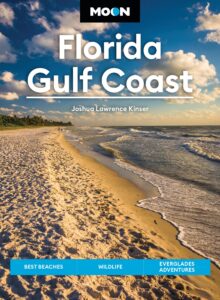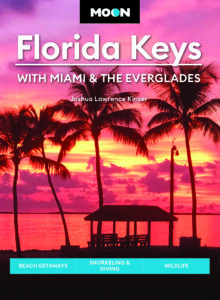Amelia Island to the Fountain of Youth
Amelia Island
Entering Florida from Georgia across the St. Marys River, which flows east out of the Okefenokee Swamp to the Atlantic Ocean, you may want to skirt around the metropolitan sprawl of Jacksonville by following old US-17, or getting off I-95 at exit 129, to Hwy-A1A, which runs due east to the brilliant white-sand beaches and picturesque historic buildings of Amelia Island. The main community on the island is Fernandina Beach (pop. 12,558), once the main port in northeast Florida. The eastern terminus of the first trans-Florida railroad, and long a popular tourist destination, Fernandina Beach retains many late-Victorian buildings, collected together in a wanderable 50-block historic district along the Amelia Island bay front.
A local landmark, the Florida House Inn (22 S. 3rd St., 904/491-3322, $140 and up) is Florida’s oldest hotel, welcoming travelers since 1857, while at the center of town the lively Palace Saloon (117 Centre St., 844/421-2444) is another of “Florida’s Oldest,” with a lovely carved wood bar, great punch, and regular live music.
More history has been preserved at the north end of Amelia Island, adjacent to Fernandina Beach, where the well-preserved remnants of a pre-Civil War brick fortress stand in Fort Clinch State Park (904/277-7274, daily, $6 per car, $2 per person for the fort), with over 1,400 acres of marshes, sand dunes, and coastal hammock forests, plus a nice campground, along the edge of Cumberland Sound.
South of Fernandina Beach, Hwy-A1A follows Fletcher Avenue along Amelia Island’s gorgeous white beaches, passing upscale resorts (including a Ritz-Carlton) before crossing over a bridge onto Talbot Island. Amid the dense native jungles of Little Talbot Island, a large state park (904/251-2320, daily dawn-dusk, $5 per car) has hiking and cycling trails, a nice campground, and a magnificent beach.
Jacksonville Beach
East of Jacksonville, at the mouth of the St. Johns River, Hwy-A1A curves around a large U.S. Navy base (third largest in the country, specializing in helicopters, which you’ll often see hovering overhead), past the busy Bath Iron Works shipyard and the sizable fishing port of Mayport, where you can enjoy a quick bite at Singleton’s Seafood Shack (4728 Ocean St., 904/246-4442), about 170 yards west of the ferry landing. From Mayport, Hwy-A1A zigzags inland south and east, reaching the water again at Jacksonville Beach, a welcoming, family-oriented community with the usual gauntlet of cafés, mini-golf courses, and video arcades, and a nice beachfront centering on a small pier.
South of Jacksonville Beach spreads the enclave of Ponte Vedra Beach, where country club resorts replace roadside sprawl. Hwy-A1A bends inland through here, so if you want to keep close to the shore (most of which is private), follow Hwy-203 instead, rejoining Hwy-A1A on the edge of town.
South of Ponte Vedra, Hwy-A1A passes a pair of beachfront state parks: the marvelous 9,815-ac (3,972-ha) Guana River and smaller South Ponte Vedra, both of which give access to usually uncrowded sands.
Fountain of Youth
North of St. Augustine, Hwy-A1A cuts inland from the shore, crossing a bridge over the Tolomato River, then following San Marco Avenue south into the center of St. Augustine past the Fountain of Youth (904/829-3168, 9am-6pm daily, $16 adults). That’s right, the Fountain of Youth. Though its efficacy has never been proven in court, there is an actual site where Spanish explorer Ponce de León, searching for a fabled spring that would keep him forever young, came ashore in 1513. Now a pleasant 15-ac (6-ha) park, facing Matanzas Bay about a mile north of central St. Augustine, the Fountain of Youth preserves a naturally sulfurous spring (which you can drink from using Dixie cups—though there are no guarantees of immortality!), a burial ground, and remnants of an indigenous Timucuan village and an early Spanish settlement.
Related Travel Map
















